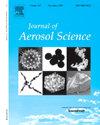Evaluation of methods for aerosolising polystyrene latex nanoparticles and assessment of their toxicity
IF 2.9
3区 环境科学与生态学
Q2 ENGINEERING, CHEMICAL
引用次数: 0
Abstract
Aerosolised Polystyrene Latex (PSL) nanoparticles are, due to their well-defined size, spherical shape, and inert surface, useful in many experimental applications, including studies of particle deposition in the human lung. Aerosolising nanoparticles entails added challenges, and nanoparticles can potentially be more hazardous than otherwise equivalent microparticles. The objective of this work was to evaluate methods for aerosolising PSL nanoparticles and assess their toxicity.
We investigated a Collison-type generator, a TSI Electrospray, and the recent Kanomax NanoAerosol Generator (NAG). We also examined the cyto- and genotoxicity of nano-PSL to human bronchial epithelial cells (BEAS-2B) in serum-free conditions and to monocyte-derived macrophages (THP-1) in both serum-free and serum-enriched conditions.
When comparing the generators, we found that the NAG produced an aerosol with greater separation between the PSL and residual particles than the Collison and was the most stable generator tested. The electrospray generated an aerosol without any overlap between the residual and the PSL modes but was also the most unpredictable, making it less suited for areas where ease of use and high repeatability are needed. We found that the Collison is generally unsuitable to generate nano-sized aerosol. The lowest observed effect level for cytotoxicity in BEAS-2B was 25, 50 and 50 μg/mL for 30, 50 and 100 nm PSL, respectively. For serum-free THP-1 macrophages, it was 50 μg/mL for 30 nm PSL and 150 μg/mL for 50 and 100 nm PSL. THP-1 macrophages displayed no cytotoxicity in serum-enriched culture. None of the tested particles were genotoxic in the alkaline comet assay.
Overall, the NAG exceeded the Collison and electrospray in stability but produced a more polydisperse aerosol than the electrospray. PSL particles induced dose- and size-dependent cytotoxicity in BEAS-2B and in THP-1 cells with the smallest particles (30 nm) being the most toxic. However, the concentration is several orders of magnitude higher than typical concentrations for experimental applications.
聚苯乙烯乳胶纳米颗粒雾化方法的评价及其毒性评价
雾化聚苯乙烯乳胶(PSL)纳米颗粒由于其明确的尺寸、球形和惰性表面,在许多实验应用中都很有用,包括研究人体肺部的颗粒沉积。雾化纳米颗粒带来了额外的挑战,纳米颗粒可能比其他等效的微粒更危险。这项工作的目的是评估雾化PSL纳米颗粒的方法,并评估其毒性。我们研究了碰撞型发生器、TSI电喷雾和最近的Kanomax纳米气溶胶发生器(NAG)。我们还检测了纳米psl在无血清条件下对人支气管上皮细胞(BEAS-2B)的细胞毒性和遗传毒性,以及在无血清和富血清条件下对单核细胞源性巨噬细胞(THP-1)的细胞毒性。当比较发生器时,我们发现NAG产生的气溶胶在PSL和残余颗粒之间的分离比Collison更大,并且是测试中最稳定的发生器。电喷雾产生的气溶胶在残余和PSL模式之间没有任何重叠,但也是最不可预测的,这使得它不太适合需要易用性和高重复性的领域。我们发现碰撞一般不适合产生纳米级气溶胶。30、50和100 nm的PSL对BEAS-2B细胞毒性最低影响水平分别为25、50和50 μg/mL。对于无血清THP-1巨噬细胞,30 nm PSL为50 μg/mL, 50和100 nm PSL为150 μg/mL。THP-1巨噬细胞在血清富集培养中无细胞毒性。在碱性彗星试验中,所有被测颗粒均无基因毒性。总的来说,NAG在稳定性上超过了Collison和电喷雾,但产生了比电喷雾更分散的气溶胶。PSL颗粒对BEAS-2B和THP-1细胞产生剂量依赖性和大小依赖性的细胞毒性,其中最小颗粒(30 nm)毒性最大。然而,该浓度比实验应用的典型浓度高几个数量级。
本文章由计算机程序翻译,如有差异,请以英文原文为准。
求助全文
约1分钟内获得全文
求助全文
来源期刊

Journal of Aerosol Science
环境科学-工程:化工
CiteScore
8.80
自引率
8.90%
发文量
127
审稿时长
35 days
期刊介绍:
Founded in 1970, the Journal of Aerosol Science considers itself the prime vehicle for the publication of original work as well as reviews related to fundamental and applied aerosol research, as well as aerosol instrumentation. Its content is directed at scientists working in engineering disciplines, as well as physics, chemistry, and environmental sciences.
The editors welcome submissions of papers describing recent experimental, numerical, and theoretical research related to the following topics:
1. Fundamental Aerosol Science.
2. Applied Aerosol Science.
3. Instrumentation & Measurement Methods.
 求助内容:
求助内容: 应助结果提醒方式:
应助结果提醒方式:


